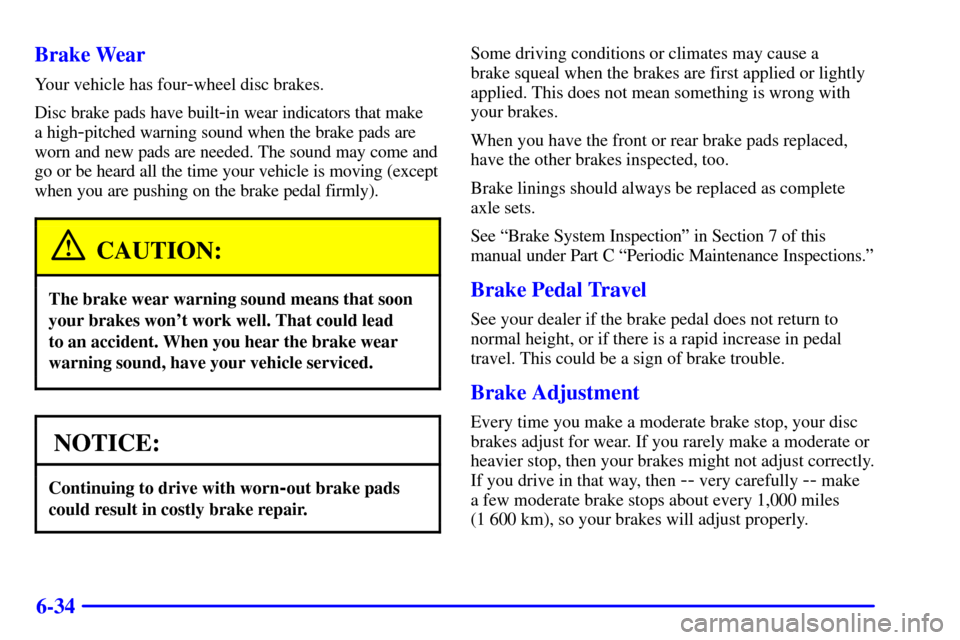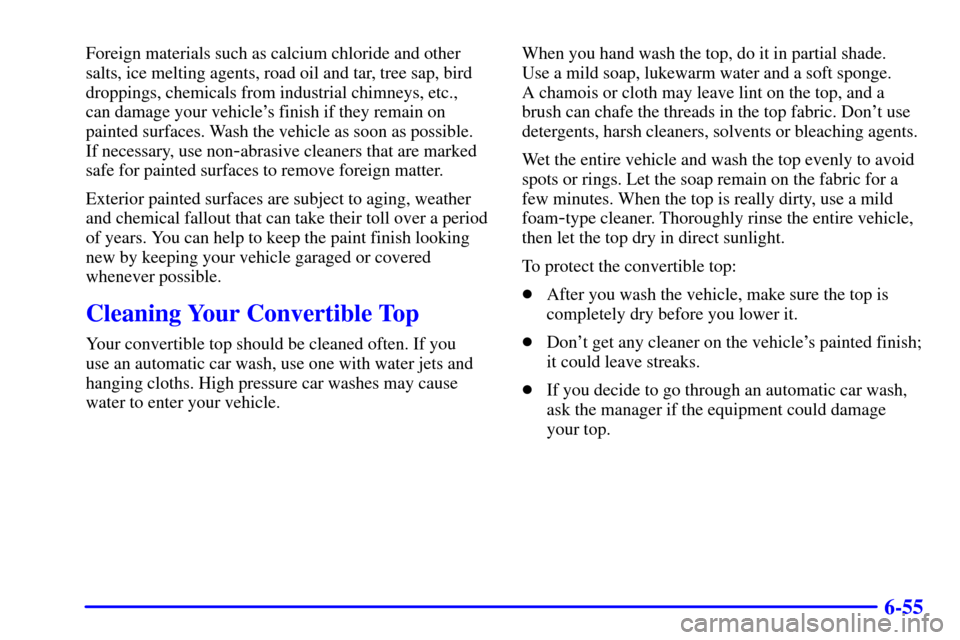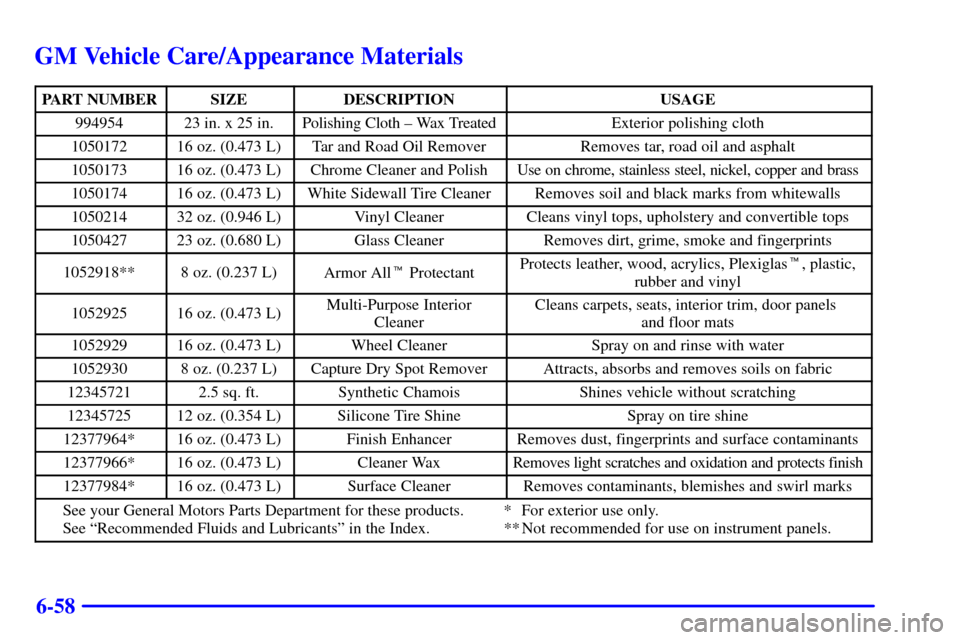Page 283 of 357

6-32
There are only two reasons why the brake fluid level in
the reservoir might go down. The first is that the brake
fluid goes down to an acceptable level during normal
brake lining wear. When new linings are put in, the fluid
level goes back up. The other reason is that fluid is
leaking out of the brake system. If it is, you should
have your brake system fixed, since a leak means that
sooner or later your brakes won't work well, or won't
work at all.
So, it isn't a good idea to ªtop offº your brake fluid.
Adding brake fluid won't correct a leak. If you add fluid
when your linings are worn, then you'll have too much
fluid when you get new brake linings. You should add
(or remove) brake fluid, as necessary, only when work is
done on the brake hydraulic system.
CAUTION:
If you have too much brake fluid, it can spill on
the engine. The fluid will burn if the engine is hot
enough. You or others could be burned, and your
vehicle could be damaged. Add brake fluid only
when work is done on the brake hydraulic system.
When your brake fluid falls to a low level, your brake
warning light will come on. See ªBrake System Warning
Lightº in the Index.
Checking Brake Fluid
You can check the brake fluid without taking off the
cap. Just look at the brake fluid reservoir. The fluid level
should be above the plastic seam in the reservoir (A).
If it isn't, have your brake system checked to see if
there is a leak.
Page 285 of 357

6-34 Brake Wear
Your vehicle has four-wheel disc brakes.
Disc brake pads have built
-in wear indicators that make
a high
-pitched warning sound when the brake pads are
worn and new pads are needed. The sound may come and
go or be heard all the time your vehicle is moving (except
when you are pushing on the brake pedal firmly).
CAUTION:
The brake wear warning sound means that soon
your brakes won't work well. That could lead
to an accident. When you hear the brake wear
warning sound, have your vehicle serviced.
NOTICE:
Continuing to drive with worn-out brake pads
could result in costly brake repair.
Some driving conditions or climates may cause a
brake squeal when the brakes are first applied or lightly
applied. This does not mean something is wrong with
your brakes.
When you have the front or rear brake pads replaced,
have the other brakes inspected, too.
Brake linings should always be replaced as complete
axle sets.
See ªBrake System Inspectionº in Section 7 of this
manual under Part C ªPeriodic Maintenance Inspections.º
Brake Pedal Travel
See your dealer if the brake pedal does not return to
normal height, or if there is a rapid increase in pedal
travel. This could be a sign of brake trouble.
Brake Adjustment
Every time you make a moderate brake stop, your disc
brakes adjust for wear. If you rarely make a moderate or
heavier stop, then your brakes might not adjust correctly.
If you drive in that way, then
-- very carefully -- make
a few moderate brake stops about every 1,000 miles
(1 600 km), so your brakes will adjust properly.
Page 287 of 357

6-36
Bulb Replacement
For the proper type of replacement bulb, see ªReplacement
Bulbsº in the Index.
For any bulb changing procedure not listed in this section,
contact your dealer's service department.
Halogen Bulbs
CAUTION:
Halogen bulbs have pressurized gas inside and
can burst if you drop or scratch the bulb. You
or others could be injured. Be sure to read and
follow the instructions on the bulb package.
Headlamps
Before replacing a headlamp bulb that does not light,
check to make sure that the wiring connector is securely
fastened to it.
See ªReplacement Bulbsº in the Index to check the type
of headlamp bulb you need to use before you begin to
replace the headlamp bulb. You must replace a headlamp
bulb with one that is exactly the same.To replace a headlamp:
1. Open the hood.
2. Locate the headlamp bulb that needs to be replaced.3. Press and turn the base one-quarter turn
counterclockwise. (See arrows).
4. Remove the socket with the burned lamp.
5. Replace the bulb and insert the socket into
the headlamp.
Page 297 of 357

6-46 Uniform Tire Quality Grading
The following information relates to the system
developed by the United States National Highway
Traffic Safety Administration, which grades tires
by treadwear, traction and temperature performance.
(This applies only to vehicles sold in the United States.)
The grades are molded on the sidewalls of most
passenger car tires. The Uniform Tire Quality Grading
system does not apply to deep tread, winter
-type snow
tires, space
-saver or temporary use spare tires, tires with
nominal rim diameters of 10 to 12 inches (25 to 30 cm),
or to some limited
-production tires.
While the tires available on General Motors passenger
cars and light trucks may vary with respect to these
grades, they must also conform to Federal safety
requirements and additional General Motors Tire
Performance Criteria (TPC) standards.Treadwear
The treadwear grade is a comparative rating based on
the wear rate of the tire when tested under controlled
conditions on a specified government test course. For
example, a tire graded 150 would wear one and a half
(1 1/2) times as well on the government course as a tire
graded 100. The relative performance of tires depends
upon the actual conditions of their use, however,
and may depart significantly from the norm due to
variations in driving habits, service practices and
differences in road characteristics and climate.
Traction -- AA, A, B, C
The traction grades, from highest to lowest, are AA,
A, B, and C. Those grades represent the tire's ability
to stop on wet pavement as measured under controlled
conditions on specified government test surfaces of
asphalt and concrete. A tire marked C may have
poor traction performance. Warning: The traction
grade assigned to this tire is based on straight
-ahead
braking traction tests, and does not include acceleration,
cornering, hydroplaning, or peak traction characteristics.
Page 306 of 357

6-55
Foreign materials such as calcium chloride and other
salts, ice melting agents, road oil and tar, tree sap, bird
droppings, chemicals from industrial chimneys, etc.,
can damage your vehicle's finish if they remain on
painted surfaces. Wash the vehicle as soon as possible.
If necessary, use non
-abrasive cleaners that are marked
safe for painted surfaces to remove foreign matter.
Exterior painted surfaces are subject to aging, weather
and chemical fallout that can take their toll over a period
of years. You can help to keep the paint finish looking
new by keeping your vehicle garaged or covered
whenever possible.
Cleaning Your Convertible Top
Your convertible top should be cleaned often. If you
use an automatic car wash, use one with water jets and
hanging cloths. High pressure car washes may cause
water to enter your vehicle.When you hand wash the top, do it in partial shade.
Use a mild soap, lukewarm water and a soft sponge.
A chamois or cloth may leave lint on the top, and a
brush can chafe the threads in the top fabric. Don't use
detergents, harsh cleaners, solvents or bleaching agents.
Wet the entire vehicle and wash the top evenly to avoid
spots or rings. Let the soap remain on the fabric for a
few minutes. When the top is really dirty, use a mild
foam
-type cleaner. Thoroughly rinse the entire vehicle,
then let the top dry in direct sunlight.
To protect the convertible top:
�After you wash the vehicle, make sure the top is
completely dry before you lower it.
�Don't get any cleaner on the vehicle's painted finish;
it could leave streaks.
�If you decide to go through an automatic car wash,
ask the manager if the equipment could damage
your top.
Page 309 of 357

6-58
GM Vehicle Care/Appearance Materials
PART NUMBERSIZEDESCRIPTIONUSAGE
99495423 in. x 25 in.Polishing Cloth ± Wax TreatedExterior polishing cloth
105017216 oz. (0.473 L)Tar and Road Oil RemoverRemoves tar, road oil and asphalt
105017316 oz. (0.473 L)Chrome Cleaner and PolishUse on chrome, stainless steel, nickel, copper and brass
105017416 oz. (0.473 L)White Sidewall Tire CleanerRemoves soil and black marks from whitewalls
105021432 oz. (0.946 L)Vinyl CleanerCleans vinyl tops, upholstery and convertible tops
105042723 oz. (0.680 L)Glass CleanerRemoves dirt, grime, smoke and fingerprints
1052918**8 oz. (0.237 L)Armor All� ProtectantProtects leather, wood, acrylics, Plexiglas�, plastic,
rubber and vinyl
105292516 oz. (0.473 L)Multi-Purpose Interior
CleanerCleans carpets, seats, interior trim, door panels
and floor mats
105292916 oz. (0.473 L)Wheel CleanerSpray on and rinse with water
10529308 oz. (0.237 L)Capture Dry Spot RemoverAttracts, absorbs and removes soils on fabric
123457212.5 sq. ft.Synthetic ChamoisShines vehicle without scratching
1234572512 oz. (0.354 L)Silicone Tire ShineSpray on tire shine
12377964*16 oz. (0.473 L)Finish EnhancerRemoves dust, fingerprints and surface contaminants
12377966*16 oz. (0.473 L)Cleaner WaxRemoves light scratches and oxidation and protects finish
12377984*16 oz. (0.473 L)Surface CleanerRemoves contaminants, blemishes and swirl marks
See your General Motors Parts Department for these products. * For exterior use only.
See ªRecommended Fluids and Lubricantsº in the Index. ** Not recommended for use on instrument panels.
Page 312 of 357
6-61 Fuses and Circuit Breakers
The wiring circuits in your vehicle are protected
from short circuits by a combination of fuses, circuit
breakers, and fusible thermal links in the wiring itself.
This greatly reduces the chance of fires caused by
electrical problems.
There are three fuse centers on your vehicle.
The main fuse block is located behind a cover on the
driver's side of the instrument panel.
The other two are located in the engine compartment.
Open the cover on either of the boxes to expose the fuses.
Look at the silver
-colored band inside the fuse. If the
band is broken or melted, replace the fuse. Be sure you
replace a bad fuse with a new one of the correct size.
If you ever have a problem on the road and don't have a
spare fuse, you can borrow one of the correct value. Just
pick some feature of your vehicle that you can get along
without
-- like the radio or cigarette lighter -- and use
its fuse, if it is the size you need. Replace it as soon as
you can.
Page 313 of 357
6-62
Main Fuse Block
Fuse Usage
STOP/HAZARD Hazard Flashers, Brake
Switch Assembly
TURN B/U Traction Control/Second
-Gear
Start Switch, Back
-Up Lamp
Switch, Turn Flasher, Daytime
Running Lamps (DRL) Module
STG WHL
CNTRLSteering Wheel ControlsFuse Usage
RADIO ACCY Delco Monsoon Radio Amplifier,
Remote CD Player (Trunk)
TAIL LPS Daytime Running Lamps (DRL)
Module, Headlamp Switch
HVAC HVAC Selector Switch,
Rear Defogger Switch/Timer
PWR ACCY Parking Lamp Relay, Hatch
Release Relay, Power Mirror
Switch, Radio, Shock Sensor,
Instrument Cluster
COURTESY Body Control Module (BCM)
GAUGESBody Control Module (BCM),
Brake
-Transmission Shift Interlock
(BTSI), Instrument Cluster,
Daytime Running Lamps
(DRL) Module
AIR BAG Air Bag System
CIG/ACCY Cigarette Lighter, Data Link
Connector (DLC)
DEFOG/SEATS Rear Defogger Switch/Timer,
Power Seats